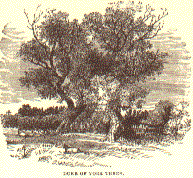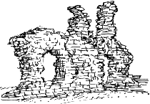
Barrage from the BroomSunday 20th August 2000, West Yorkshire WE'RE SITTING IN THE SUN, talking to friends on the back lawn. I'm vaguely aware of occasional clicks behind me, as if someone is clicking their fingers.  Then I feel a small sharp tap on my neck, like a wasp flying into me at speed. Then I feel a small sharp tap on my neck, like a wasp flying into me at speed.'Do you realise,' my friend asks, 'that the pods of that Broom behind you keep exploding?' The brown pods are spring-loaded - the two halves of the pod twist outwards, flinging away the pale brown seeds that resemble small grape pips. Planta genêt The Plantagenet kings of England take their name from Geoffrey, Count of Anjou's fondness for broom, Planta genêt. According to tradition, he either wore a sprig of broom in his cap or planted broom to improve the cover in his hunting parks. He married Matilda, also known as the Empress Maud, in 1128. Their son Henry (the II), who was to be the first of the 'Plantagenet' line (also known as the House of Anjou or the Angevin Dynasty) was born in 1133.
The Plantagenet kings of England take their name from Geoffrey, Count of Anjou's fondness for broom, Planta genêt. According to tradition, he either wore a sprig of broom in his cap or planted broom to improve the cover in his hunting parks. He married Matilda, also known as the Empress Maud, in 1128. Their son Henry (the II), who was to be the first of the 'Plantagenet' line (also known as the House of Anjou or the Angevin Dynasty) was born in 1133. Some Yorkshire connections; Matilda's father, Henry I, youngest son of William the Conqueror, was born in Selby just 3 years after the Battle of Hastings. Richard of York was the first of the family to use the nickname as his official surname, claiming the throne as 'Richard Plantaginet' in 1460. He was beheaded after the Battle of Wakefield on the 30th December that same year. The White Rose of York, rather than the Broom, has become the symbol for his Yorkist branch of the family. His son, Richard III had a new tower built at Sandal Castle, Wakefield. Richard III was the last of the (Yorkist) Plantagenet line, defeated by Henry Tudor at the Battle of Bosworth Field , near Leicester, on the 22nd August 1485.
Some Yorkshire connections; Matilda's father, Henry I, youngest son of William the Conqueror, was born in Selby just 3 years after the Battle of Hastings. Richard of York was the first of the family to use the nickname as his official surname, claiming the throne as 'Richard Plantaginet' in 1460. He was beheaded after the Battle of Wakefield on the 30th December that same year. The White Rose of York, rather than the Broom, has become the symbol for his Yorkist branch of the family. His son, Richard III had a new tower built at Sandal Castle, Wakefield. Richard III was the last of the (Yorkist) Plantagenet line, defeated by Henry Tudor at the Battle of Bosworth Field , near Leicester, on the 22nd August 1485. I lead walks for Wakefield's Further Education Service, based at Manygates,
Sandal. A memorial to the Duke of York stands just outside the coffee bar there,
overlooking Manygates Park* where traces of medieval fields remain. Before Manygates
school was built a group of ancient willows trees were said to mark the spot.
Apart from a sword dating from the period very little evidence of the battle
has been found. Richard's head was set on Mickelgate Bar, York, wearing
a paper crown, as Shakespeare has Queen Margaret say;
I lead walks for Wakefield's Further Education Service, based at Manygates,
Sandal. A memorial to the Duke of York stands just outside the coffee bar there,
overlooking Manygates Park* where traces of medieval fields remain. Before Manygates
school was built a group of ancient willows trees were said to mark the spot.
Apart from a sword dating from the period very little evidence of the battle
has been found. Richard's head was set on Mickelgate Bar, York, wearing
a paper crown, as Shakespeare has Queen Margaret say;'that York may overlook the town of York'
*'The proper name for this open area is Castle Grove Park.' writes Gerrard Kittson of Sandal, 'Previously belonging to Castle Grove House which was where the housing development called Miller Avenue now exists. 'Manygates Park is the name of the grounds of Manygates House which lies to the west of the A61 Barnsley road at Haddingley Hill. Manygates House, until recentley part of Leeds University Campus, was for many years a Maternity Hospital.' That interests me because I was very
nearly born at the hospital. My mum and dad turned up there but, this being
the 'baby boom' years after the war, they were redirected to the Manygates
Hospital annexe: Walton Hall. Related LinkThe Plantagenets, on the Official British Monarchy web site.
|

 It's pleasant to take our friends on our regular walk, but, distracted by conversation, we don't notice much in the way of wildlife. I point out the Field Scabious which is growing on the turf on top of a drystone wall. Faded, slightly tattered, Gatekeepers and Meadow Browns are on the wing.
It's pleasant to take our friends on our regular walk, but, distracted by conversation, we don't notice much in the way of wildlife. I point out the Field Scabious which is growing on the turf on top of a drystone wall. Faded, slightly tattered, Gatekeepers and Meadow Browns are on the wing.